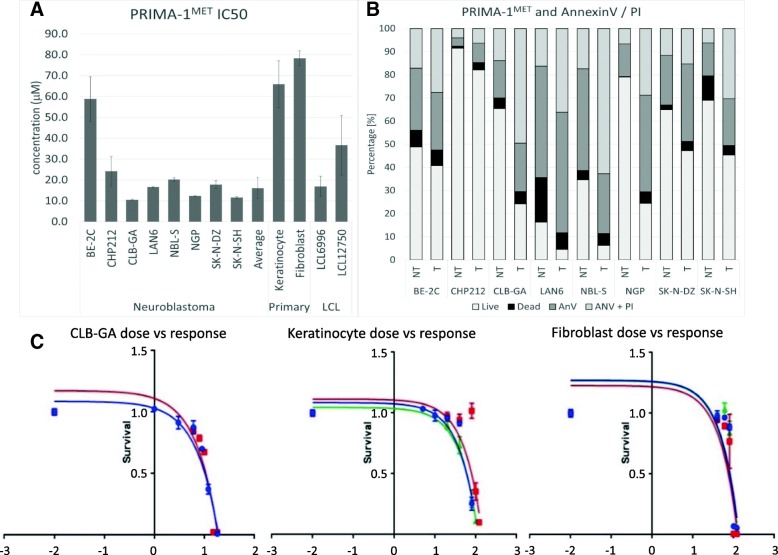Fig. 1.
PRIMA-1MET IC50 values. a: PRIMA-1MET IC50 values. Eight NB cell lines were tested for PRIMA-1MET IC50 values: BE-2C (58.8 + − 10.72 μM), CHP212 (24.2 + − 7.02 μM), CLB-GA (10.5 + − 0.34 μM), LAN6 (16.5 μM + − 0.48), NBL-S (20.1 + − 0.80 μM), NGP (12.3 + − 0.27 μM), SK-N-DZ (17.8 + − 1.95 μM) and SK-N-SH (11.6 + − 0.55 μM). The average IC50 (excluding resistant BE-2C) for NB cell lines was 16.1 + − 4.99 μM. The PRIMA-1MET IC50 values for the non-tumor cells were: 65.8 + − 11.2 μM (keratinocytes), 78.3 + − 3.69 μM (fibroblasts), 16.9 + − 4.96 μM (LCL6996) and 36.6 + − 14.32 μM (LCL12750). No significant impact of MNA or 11q status on IC50 was observed. b: Graph shows increase in dead (black), early apoptotic (dark grey), and late apoptotic (light grey) cells and decrease in live cells (white) 16 h after PRIMA-1MET treatment at IC50 concentration. Treatment with PRIMA-1MET results in significant overall increase in the three populations (dead, early, and late apoptosis) combined and in AnnexinV-positive cells (early and late apoptosis), demonstrating activation of apoptosis after PRIMA-1MET. NT – non-treated vehicle control, T – treatment with PRIMA-1MET. c: The graph shows a non-linear regression fitting for IC50 calculation (BE-2C, keratinocytes, and fibroblasts). The steepness of the curve illustrates PRIMA-1MET’s narrow activation window

